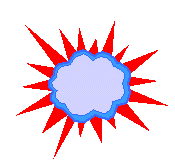Tertiary Structures are
formed as follows:
-
The primary structure
of a polypeptide is a chain of amino acids in a very specific sequence
which can fold up to form any of the 3 kinds of secondary
structure.
-
The different
elements of secondary structure can then "pack" together to form a 3-D
SHAPE! This is called the tertiary
structure of the protein.
Whale
Myoglobin. An example which shows how secondary
structures form tertiary structure
is whale myoglobin. This protein is similar to human
b
globin and binds oxygen. It is found
in the muscles of all vertebrates and serves as a storage mechanism for
oxygen between the time it is delivered to the muscle cell by the blood
and the time it is used in oxidative phosphorylation. The tissues
of whales are loaded with this protein, and it is one reason that they
can stay beneath the surface for nearly an hour. The rusty red structure
is the porphyrin ring which traps an iron
atom. Since iron is easily oxidized (as in iron oxide or
rust), it complexes with the oxygen absorbed from the blood, and "stores"
it until it is used by the muscles.
3 views of whale myoglobin tertiary
structure:
-
In the drawing
of whale myoblobin above, it can be seen that a SHAPE
is formed when the different regions of a
helix fold up on each other.
This SHAPE is a third level of structure - tertiary
structure.
-
A different way of depicting the whale
myoglobin is shown in the stereo cartoon image
of whale myoglobin. This shows how the tertiary
structure is formed from 2 different kinds of secondary structure;
random
coil is the gray strand and
a
helix is shown by the magenta
coils.
NOTE: View
this as a stereo image and note that the folding creates a 3D structure!
-
Another way of depicting whale myoglobin
is shown in the stereo space filling image
of whale myoglobin (this is the same molecule, in the same orientation,
with the same color coding). Here, it can be seen how the tertiary
structure produces a SHAPE.
 The
Tertiary
Structure determines the SHAPE
of the protein! The
Tertiary
Structure determines the SHAPE
of the protein! |
What
is so important about SHAPE?